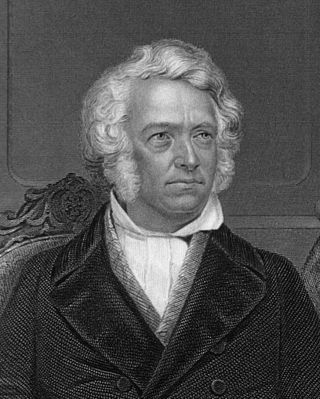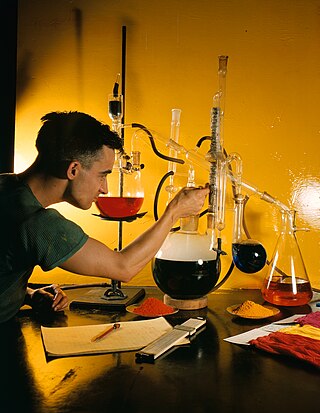Related Research Articles

Clinical chemistry is a division in medical laboratory sciences focusing on qualitative tests of important compounds, referred to as analytes or markers, in bodily fluids and tissues using analytical techniques and specialized instruments. This interdisciplinary field includes knowledge from medicine, biology, chemistry, biomedical engineering, informatics, and an applied form of biochemistry.

Bilirubin (BR) is a red-orange compound that occurs in the normal catabolic pathway that breaks down heme in vertebrates. This catabolism is a necessary process in the body's clearance of waste products that arise from the destruction of aged or abnormal red blood cells. In the first step of bilirubin synthesis, the heme molecule is stripped from the hemoglobin molecule. Heme then passes through various processes of porphyrin catabolism, which varies according to the region of the body in which the breakdown occurs. For example, the molecules excreted in the urine differ from those in the feces. The production of biliverdin from heme is the first major step in the catabolic pathway, after which the enzyme biliverdin reductase performs the second step, producing bilirubin from biliverdin.

Leopold Gmelin was a German chemist. Gmelin was a professor at the University of Heidelberg. He worked on the red prussiate and created Gmelin's test, and wrote his Handbook of Chemistry, which over successive editions became a standard reference work still in use.

Urinalysis, a portmanteau of the words urine and analysis, is a panel of medical tests that includes physical (macroscopic) examination of the urine, chemical evaluation using urine test strips, and microscopic examination. Macroscopic examination targets parameters such as color, clarity, odor, and specific gravity; urine test strips measure chemical properties such as pH, glucose concentration, and protein levels; and microscopy is performed to identify elements such as cells, urinary casts, crystals, and organisms.

In chemistry, a chemical test is a qualitative or quantitative procedure designed to identify, quantify, or characterise a chemical compound or chemical group.

Urobilin or urochrome is the chemical primarily responsible for the yellow color of urine. It is a linear tetrapyrrole compound that, along with the related colorless compound urobilinogen, are degradation products of the cyclic tetrapyrrole heme.
The Carius halogen method in analytical chemistry is a method for the quantitative determination of halogens in chemical substances.

A urine test strip or dipstick is a basic diagnostic tool used to determine pathological changes in a patient's urine in standard urinalysis.
Rosenbach's test is a qualitative medical test to detect the presence of bile in urine. To carry out the test, the urine is passed through the same filter paper several times. The filter paper is then dried, and a drop of nitric acid is added. In the presence of bile, the characteristic bile pigment colours appear.

Xanthoproteic acid is a non-crystallizable yellow substance derived from proteins upon treatment with nitric acid. Nitric acid reacts with proteins to form xanthoproteic acid. This reaction is known as the xanthoproteic reaction. This test is carried out by adding concentrated nitric acid to the substance being tested, and then heating the mixture. If proteins are present that contains amino acids with aromatic rings, the mixture turns yellow. Upon adding a strong base, such as ammonia solution, the color turns orange. These color changes are caused by nitrated aromatic rings in the protein. The xanthoproteic test is specific for aromatic compounds such as tyrosine, tryptophan and phenylalanine.

The xanthoproteic reaction is a method that can be used to detect a presence of protein soluble in a solution, using concentrated nitric acid. The test gives a positive result in amino acids carrying aromatic groups, especially in the presence of tyrosine. If the test is positive the proof is neutralized with an alkali, turning dark yellow. The yellow colour is due to xanthoproteic acid which is formed due to nitration of certain amino acids, most common examples being tyrosine and tryptophan. This chemical reaction is a qualitative test, determining the presence or absence of proteins.

The Sakaguchi test is a chemical test used to detect presence of arginine in proteins. It is named after the Japanese food scientist and organic chemist, Shoyo Sakaguchi (1900–1995) who described the test in 1925. The Sakaguchi reagent used in the test consists of 1-Naphthol and a drop of sodium hypobromite. The guanidino (–C group in arginine reacts with the Sakaguchi reagent to form a red-coloured complex.
The Hopkins-Cole reaction, also known as the glyoxylic acid reaction, is a chemical test used for detecting the presence of tryptophan in proteins. A protein solution is mixed with Hopkins Cole reagent, which consists of glyoxylic acid. Concentrated sulfuric acid is slowly added to form two layers. A purple ring appears between the two layers if the test is positive for tryptophan. Nitrites, chlorates, nitrates and excess chlorides prevent the reaction from occurring.
The Acree-Rosenheim reaction is a chemical test used for detecting the presence of tryptophan in proteins. A protein mixture is mixed with formaldehyde. Concentrated sulfuric acid is added to form two layers. A purple ring appears between the two layers if the test is positive for tryptophan.
Nylander's test is a chemical test used for detecting the presence of reducing sugars. Glucose or fructose reduces bismuth oxynitrate to bismuth under alkaline conditions. When Nylander's reagent, which consists of bismuth nitrate, potassium sodium tartrate and potassium hydroxide, is added to a solution with reducing sugars, a black precipitate of metallic bismuth is formed.
Heller's test is a chemical test that shows that strong acids cause the denaturation of precipitated proteins. Concentrated nitric acid is added to a protein solution from the side of the test tube to form two layers. A white ring appears between the two layers if the test is positive. Heller's test is commonly used to test for the presence of proteins in urine. This test was discovered by the Austrian Chemist, Johann Florian Heller (1813-1871).
Gunzberg's test is a chemical test used for detecting the presence of hydrochloric acid. Gunzberg's reagent is made by dissolving two grams of phloroglucinol and one gram of vanillin in 100 millilitres of 95% ethanol. Hydrochloric acid catalyses Gunzberg's reagent to form a red complex.
Kelling's test is a chemical test used for detecting the presence of lactic acid in gastric juice.
Hay's test, also known as Hay's sulphur powder test, is a chemical test used for detecting the presence of bile salts in urine.
Salkowski's test, also known simply as Salkowski test, is a qualitative chemical test, that is used in chemistry and biochemistry for detecting a presence of cholesterol and other sterols. This biochemical method got its name after German biochemist Ernst Leopold Salkowski, who is known for development of multiple new chemical tests, that are used for detection of different kinds of molecules. A solution that has tested positive on the Salkowski's test becomes red and gets yellow glow.
References
- ↑ Erwin Kuntz; Hans-Dieter Kuntz (11 March 2009). Hepatology: Textbook and Atlas. Springer. p. 11. ISBN 978-3-540-76839-5.
- ↑ John Daintith; Derek Gjertsen (4 March 1999). A Dictionary of Scientists. Oxford University Press. p. 216. ISBN 978-0-19-280086-2.
- ↑ John Daintith (12 December 2010). Biographical Encyclopedia of Scientists, Third Edition. CRC Press. p. 295. ISBN 978-1-4200-7272-3.
- ↑ Srinivas B Rao. Practical Biochemistry for Medical Students. Academic Publishers. p. 56.
- ↑ Dandekar (1 January 2004). Practicals And Viva In Medical Biochemistry. Elsevier India. p. 47. ISBN 978-81-8147-025-6.
- ↑ D M Vasudevan (2013). Textbook of Biochemistry for Medical Students. JP Medical Ltd. p. 279. ISBN 978-93-5090-530-2.
- ↑ Malhotra (1 January 2003). Practical Biochemistry for Students. Jaypee Brothers Publishers. p. 46. ISBN 978-81-8061-109-4.[ permanent dead link ]
- ↑ A.C. Croftan. Clinical Urinology. Рипол Классик. p. 123. ISBN 978-1-275-01265-3.